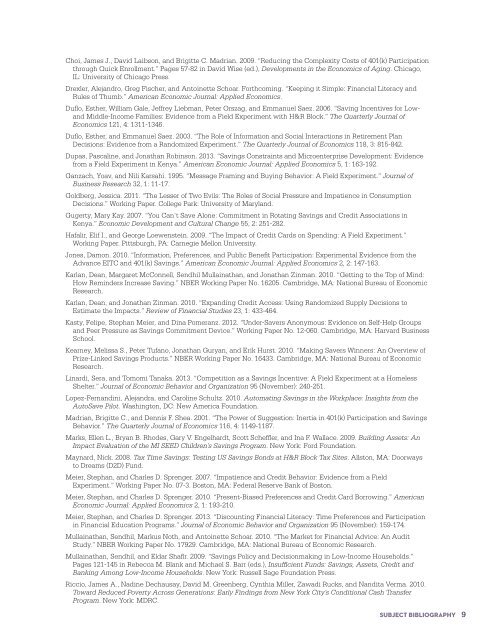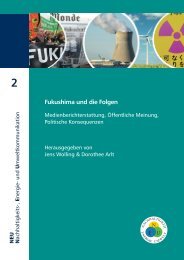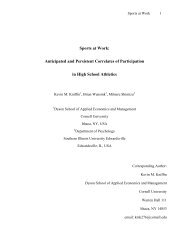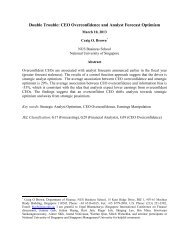bias_2014_report_technical_supplement
bias_2014_report_technical_supplement
bias_2014_report_technical_supplement
Create successful ePaper yourself
Turn your PDF publications into a flip-book with our unique Google optimized e-Paper software.
Choi, James J., David Laibson, and Brigitte C. Madrian. 2009. “Reducing the Complexity Costs of 401(k) Participationthrough Quick Enrollment.” Pages 57-82 in David Wise (ed.), Developments in the Economics of Aging. Chicago,IL: University of Chicago Press.Drexler, Alejandro, Greg Fischer, and Antoinette Schoar. Forthcoming. “Keeping it Simple: Financial Literacy andRules of Thumb.” American Economic Journal: Applied Economics.Duflo, Esther, William Gale, Jeffrey Liebman, Peter Orszag, and Emmanuel Saez. 2006. “Saving Incentives for LowandMiddle-Income Families: Evidence from a Field Experiment with H&R Block.” The Quarterly Journal ofEconomics 121, 4: 1311-1346.Duflo, Esther, and Emmanuel Saez. 2003. “The Role of Information and Social Interactions in Retirement PlanDecisions: Evidence from a Randomized Experiment.” The Quarterly Journal of Economics 118, 3: 815-842.Dupas, Pascaline, and Jonathan Robinson. 2013. “Savings Constraints and Microenterprise Development: Evidencefrom a Field Experiment in Kenya.” American Economic Journal: Applied Economics 5, 1: 163-192.Ganzach, Yoav, and Nili Karsahi. 1995. “Message Framing and Buying Behavior: A Field Experiment.” Journal ofBusiness Research 32, 1: 11-17.Goldberg, Jessica. 2011. “The Lesser of Two Evils: The Roles of Social Pressure and Impatience in ConsumptionDecisions.” Working Paper. College Park: University of Maryland.Gugerty, Mary Kay. 2007. “You Can’t Save Alone: Commitment in Rotating Savings and Credit Associations inKenya.” Economic Development and Cultural Change 55, 2: 251-282.Hafalir, Elif I., and George Loewenstein. 2009. “The Impact of Credit Cards on Spending: A Field Experiment.”Working Paper. Pittsburgh, PA: Carnegie Mellon University.Jones, Damon. 2010. “Information, Preferences, and Public Benefit Participation: Experimental Evidence from theAdvance EITC and 401(k) Savings.” American Economic Journal: Applied Economics 2, 2: 147-163.Karlan, Dean, Margaret McConnell, Sendhil Mullainathan, and Jonathan Zinman. 2010. “Getting to the Top of Mind:How Reminders Increase Saving.” NBER Working Paper No. 16205. Cambridge, MA: National Bureau of EconomicResearch.Karlan, Dean, and Jonathan Zinman. 2010. “Expanding Credit Access: Using Randomized Supply Decisions toEstimate the Impacts.” Review of Financial Studies 23, 1: 433-464.Kasty, Felipe, Stephan Meier, and Dina Pomeranz. 2012. “Under-Savers Anonymous: Evidence on Self-Help Groupsand Peer Pressure as Savings Commitment Device.” Working Paper No. 12-060. Cambridge, MA: Harvard BusinessSchool.Kearney, Melissa S., Peter Tufano, Jonathan Guryan, and Erik Hurst. 2010. “Making Savers Winners: An Overview ofPrize-Linked Savings Products.” NBER Working Paper No. 16433. Cambridge, MA: National Bureau of EconomicResearch.Linardi, Sera, and Tomomi Tanaka. 2013. “Competition as a Savings Incentive: A Field Experiment at a HomelessShelter.” Journal of Economic Behavior and Organization 95 (November): 240-251.Lopez-Fernandini, Alejandra, and Caroline Schultz. 2010. Automating Savings in the Workplace: Insights from theAutoSave Pilot. Washington, DC: New America Foundation.Madrian, Brigitte C., and Dennis F. Shea. 2001. “The Power of Suggestion: Inertia in 401(k) Participation and SavingsBehavior.” The Quarterly Journal of Economics 116, 4: 1149-1187.Marks, Ellen L., Bryan B. Rhodes, Gary V. Engelhardt, Scott Scheffler, and Ina F. Wallace. 2009. Building Assets: AnImpact Evaluation of the MI SEED Children’s Savings Program. New York: Ford Foundation.Maynard, Nick. 2008. Tax Time Savings: Testing US Savings Bonds at H&R Block Tax Sites. Allston, MA: Doorwaysto Dreams (D2D) Fund.Meier, Stephan, and Charles D. Sprenger. 2007. “Impatience and Credit Behavior: Evidence from a FieldExperiment.” Working Paper No. 07-3. Boston, MA: Federal Reserve Bank of Boston.Meier, Stephan, and Charles D. Sprenger. 2010. “Present-Biased Preferences and Credit Card Borrowing.” AmericanEconomic Journal: Applied Economics 2, 1: 193-210.Meier, Stephan, and Charles D. Sprenger. 2013. “Discounting Financial Literacy: Time Preferences and Participationin Financial Education Programs.” Journal of Economic Behavior and Organization 95 (November): 159-174.Mullainathan, Sendhil, Markus Noth, and Antoinette Schoar. 2010. “The Market for Financial Advice: An AuditStudy.” NBER Working Paper No. 17929. Cambridge, MA: National Bureau of Economic Research.Mullainathan, Sendhil, and Eldar Shafir. 2009. “Savings Policy and Decisionmaking in Low-Income Households.”Pages 121-145 in Rebecca M. Blank and Michael S. Barr (eds.), Insufficient Funds: Savings, Assets, Credit andBanking Among Low-Income Households. New York: Russell Sage Foundation Press.Riccio, James A., Nadine Dechausay, David M. Greenberg, Cynthia Miller, Zawadi Rucks, and Nandita Verma. 2010.Toward Reduced Poverty Across Generations: Early Findings from New York City’s Conditional Cash Transfer Program. New York: MDRC.Subject Bibliography 9







